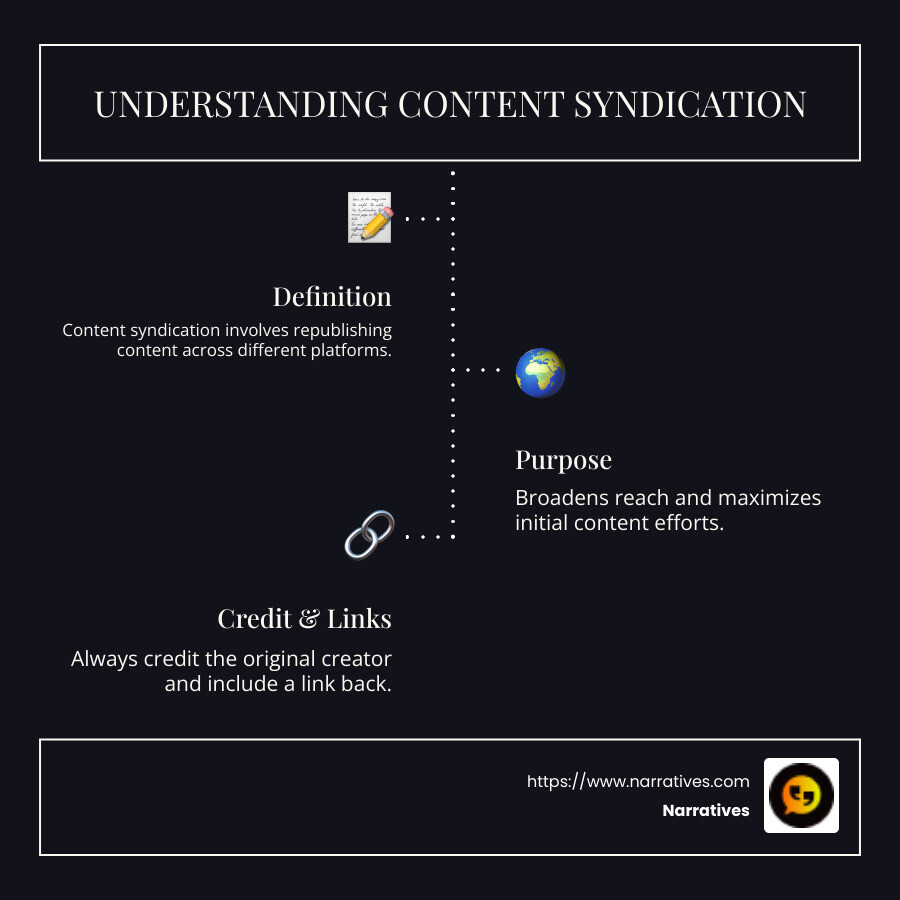Content Syndication Explained: Everything You Need to Know

Content syndication meaning is the practice of republishing content on different platforms or sites to broaden its reach and impact. Here's what you need to understand:
- Definition: Content syndication involves distributing the same content across multiple sites or platforms.
- Purpose: This strategy helps in reaching a wider audience without creating new content from scratch.
- Credit and Links: Syndicated content should always credit the original creator and include a link back to the original source.
In today's digital landscape, getting your message across to a larger audience can be a game-changer, especially for organizations focused on advocacy and social impact. By republishing existing content, you can maximize your initial content creation efforts and improve your brand's visibility and authority.
Organizations with powerful stories, such as those in social justice or environmental advocacy, often find themselves limited by resources and bandwidth. Content syndication offers a streamlined way to amplify these narratives without overextending resources.
For mission-driven brands and non-profits, content syndication is an opportunity to extend their reach, engage new audiences, and ultimately amplify their mission-driven storytelling.

Essential content syndication meaning terms:
What is Content Syndication?
Content syndication meaning is simple: it’s the practice of republishing your content on other platforms to reach more people. This strategy allows you to distribute the same piece of content across multiple sites, expanding your audience without the need to create new material from scratch.
Here's how it works:
Republishing: Your original content, whether it's a blog post, article, or video, is shared on another site. This can be in full, as a summary, or even just an excerpt.
Distribution: The content is distributed to sites that attract audiences similar to yours but aren't direct competitors. This could include blogs, media outlets, or even social media platforms.
Key Points to Remember:
Credit and Links: Always ensure that the syndicated content credits you as the original creator and includes a link back to your original work. This not only acknowledges your authorship but also helps drive traffic back to your site.
Broader Reach: By distributing content across various platforms, you can reach audiences who might not have found your content otherwise. This is especially valuable for nonprofits, advocacy groups, and organizations with limited resources.
Resource Efficiency: Instead of constantly creating new content, syndication lets you make the most of what you’ve already produced, saving time and effort while still amplifying your message.
For organizations focused on impactful storytelling—like those in social justice or environmental causes—content syndication offers a powerful way to extend their reach and engage new audiences. It’s not just about spreading content; it’s about amplifying your voice and mission.
Benefits of Content Syndication
Content syndication offers numerous advantages that can significantly boost your marketing efforts. Let's explore the key benefits:
1. Brand Awareness
By syndicating your content, you can increase your brand's visibility. When your content appears on multiple platforms, more people see it, leading to greater brand recognition. This exposure can make your brand more memorable, helping you stand out in a crowded market.
Imagine your article about environmental sustainability being featured on a popular eco-friendly blog. Not only does this introduce your brand to a new audience, but it also associates your name with important topics, enhancing your reputation.
2. SEO
Syndicated content can improve your search engine optimization (SEO). When your content is published on reputable sites, it often includes a backlink to your website. These backlinks are crucial for SEO because they signal to search engines that your site is trustworthy and authoritative.

Plus, syndicating your content can establish you as a thought leader in your industry, further boosting your credibility and authority.
3. Lead Generation
Content syndication is an effective strategy for generating leads. By reaching a wider audience, you increase the chances of attracting potential customers who are interested in what you offer. This is particularly beneficial for B2B companies, where connecting with the right audience at the right time is crucial.
For instance, if you're a nonprofit organization, syndicating a compelling story about your latest project could attract donors or volunteers who are passionate about your cause.
4. Backlinks
Backlinks are a significant benefit of content syndication. They not only improve your SEO but also drive direct traffic to your site. When readers come across your syndicated content and find it valuable, they're likely to follow the link back to your website for more information.
This not only increases your site traffic but also improves the likelihood of conversions, whether that means signing up for a newsletter, making a donation, or purchasing a product.
By leveraging content syndication, you can amplify your reach, improve your SEO, and generate more leads, all while maximizing the value of your existing content. Next, we'll explore how to effectively syndicate your content, whether through free or paid options.
How to Syndicate Content
Syndicating your content effectively can open doors to new audiences and boost your brand's online presence. Let's explore the steps and options for syndicating your content.
Free Syndication
Free content syndication is an excellent starting point, especially if you're on a budget. Here are some ways you can syndicate your content for free:
Public Websites: Platforms like Medium and LinkedIn allow you to republish entire articles from your website. This means you can share your content with a broader audience without any cost. Make sure to give credit to the original source to maintain transparency and build trust.
Industry Blogs: Reach out to industry-specific or special-interest blogs that align with your niche. If your content fits their audience's interests, they may be willing to republish it. For example, a blog about sustainable living might be interested in your article on eco-friendly initiatives.
Community Forums: Engage with platforms like Reddit and niche Facebook groups. As shared by Allen Brouwer and Cathryn Lavery, it's crucial to understand the community's language and culture before posting. Provide value rather than spam, and you'll likely see positive engagement.
Paid Syndication
For those with a budget, paid content syndication can help you reach larger audiences more quickly. Here's how it works:
Content Discovery Networks: Platforms like Outbrain and Taboola make it possible for smaller brands to appear as recommended content on high-traffic sites like CNN or BBC. You set a budget, and these platforms display your content as sponsored articles to targeted audiences.
Cost Models: Paid syndication often operates on a pay-per-click (PPC) or cost-per-lead (CPL) model. This means you pay for each click or lead generated from your syndicated content. It's crucial to allocate your budget wisely and track performance to ensure a good return on investment.
Choosing the Right Platforms
Selecting the right platforms for syndication is key to reaching your target audience effectively:
Relevance and Authority: Choose platforms that have an audience similar to your target demographic. Ensure they have a good reputation and authority in your industry to maximize the impact of your content.
Avoiding Low-Quality Sites: Stay away from platforms with low authority or spammy links, as they can harm your brand and SEO performance. Look for sites that have clear editorial guidelines and a readership that matches your buyer persona.
By understanding the differences between free and paid content syndication, and selecting the right platforms, you can effectively expand your reach and improve your marketing efforts. Next, we'll dig into the relationship between content syndication and SEO, and how to steer potential pitfalls.
Content Syndication and SEO
Navigating content syndication can be a game-changer for your SEO strategy, but it's crucial to understand the nuances to avoid potential pitfalls. Let's explore how syndication impacts SEO, focusing on duplicate content, canonical tags, and overall SEO performance.
Duplicate Content: A Double-Edged Sword
When you syndicate content, you're essentially republishing the same material across multiple platforms. This can raise concerns about duplicate content, which search engines like Google typically frown upon. Duplicate content can confuse search engines, making it difficult for them to determine which version of the content should rank higher.
However, syndicated content isn't necessarily a bad thing. When done correctly, it can improve your SEO by driving traffic and building backlinks. The key is ensuring search engines know where the original content lives.
Canonical Tags: Your SEO Lifesaver
Enter the canonical tag—a simple yet powerful tool in your SEO toolkit. A canonical tag is an HTML element that helps search engines identify the original source of syndicated content. By using a canonical tag, you signal to search engines that the version on your site is the original and should be prioritized in search results.
Here's what a canonical tag looks like:
<link rel="canonical" href="https://www.yourwebsite.com/original-article" />Incorporating these tags is crucial when republishing your content on other platforms. It ensures that your original content maintains its SEO value and doesn't get lost in the sea of duplicate content.
SEO Performance: Boosting Visibility and Authority
When executed correctly, content syndication can significantly improve your SEO performance. Here's how:
Backlinks: Syndication can generate valuable backlinks to your site. Each link acts as a vote of confidence, signaling to search engines that your content is trustworthy and authoritative.
Traffic: By reaching broader audiences through syndication, you can drive more traffic to your original content. Increased traffic can lead to better engagement metrics, which can positively influence your search rankings.
Brand Authority: As more sites reference your content, your brand's authority and visibility in your industry can grow, further boosting your SEO performance.
In summary, while content syndication poses some challenges, particularly around duplicate content, using canonical tags effectively can mitigate these risks. By understanding and implementing these strategies, you can harness the power of syndication to improve your site's SEO performance.
Next, we'll tackle some frequently asked questions about content syndication to further clarify any lingering doubts.
Frequently Asked Questions about Content Syndication
How does content syndication differ from guest posting?
Content syndication and guest posting are two distinct strategies for sharing content, but they serve different purposes.
Content Syndication: This involves republishing the same piece of content on multiple platforms. It's a way to reach a broader audience by distributing your existing content across various sites. The key here is that the content is not original to each site; it's reused, often with a link back to the original source to avoid issues with duplicate content.
Guest Posting: In contrast, guest posting involves creating original content specifically for another platform. This content is unique to the site where it's published and typically aims to showcase expertise, build relationships, and gain exposure to a new audience.
In summary, while content syndication focuses on distributing existing content, guest posting is about crafting new, exclusive pieces for other sites.
Can content syndication hurt my SEO?
The short answer is: it depends. Content syndication can potentially harm your SEO if not managed correctly, primarily due to concerns about duplicate content.
Duplicate Content: Search engines like Google may penalize sites that appear to have duplicate content. This happens when the same material appears in multiple locations without proper attribution, confusing search engines about which version to prioritize.
Canonical Tags: To avoid these penalties, it's crucial to use canonical tags. These tags inform search engines about the original source of the content, ensuring your site gets the SEO credit it deserves.
When done right, content syndication can actually boost your SEO by increasing traffic and generating valuable backlinks. The key is to ensure that syndicated content is properly attributed and that canonical tags are used effectively.
What are the best platforms for content syndication?
Choosing the right platforms for syndicating your content is crucial to reaching your target audience effectively. Here are some popular platforms you might consider:
Medium: Known for its wide reach and diverse audience, Medium is a great platform to republish blog posts. It allows for easy content importation and includes tools to ensure proper attribution to the original source.
LinkedIn: With its professional audience, LinkedIn is ideal for B2B content syndication. Publishing articles on LinkedIn can help increase your content's visibility among industry professionals and potential clients.
SlideShare: Perfect for visual content like presentations and infographics, SlideShare can help you reach a global audience. It’s especially useful for educational and informative content.
Each platform has its unique strengths, so choose the ones that align with your content goals and target audience. Proper use of these platforms can amplify your reach and improve your content marketing strategy.
Next, we'll explore how to effectively leverage content syndication for your brand's storytelling and social impact.
Conclusion
At Narratives, we believe in the power of storytelling to drive social change. Our mission is to help non-profits and purpose-driven organizations amplify their impact through compelling content. Content syndication is a vital part of this strategy, allowing us to share these meaningful stories with a wider audience.
Narratives and Storytelling
Storytelling is at the heart of what we do. It’s not just about telling stories; it’s about telling the right stories that resonate with audiences and inspire action. Content syndication helps us ensure these stories reach as many people as possible, maximizing their impact.
Empowering Non-Profits
Non-profits often face challenges in gaining visibility and engaging supporters. By leveraging content syndication, we can help these organizations share their missions and successes with a broader audience. This increased exposure can lead to more support, donations, and volunteers, ultimately furthering their causes.
Driving Social Impact
Our focus on social impact means we prioritize stories that matter—stories that highlight underrepresented voices and bring attention to important issues. Content syndication allows us to distribute these narratives widely, fostering greater awareness and understanding.
Join Us
If you’re a non-profit or purpose-driven organization looking to amplify your message and drive social change, let’s explore the opportunities that content syndication can offer your mission. Together, we can tell stories that inspire action and create a lasting impact.


